Qualitative Research Plan: Smoking Causes in Aboriginal Women
VerifiedAdded on 2023/06/11
|9
|2349
|184
Report
AI Summary
This qualitative research plan investigates the causes of smoking among pregnant Aboriginal women, employing a phenomenological design. The study aims to interview Aboriginal women of varying ages and pregnancy stages to understand their smoking habits. Data collection methods include direct interviews, questionnaires, and phone interviews, analyzed through coding and categorization. The plan addresses ethical considerations related to interviewing a vulnerable population, ensuring autonomy and confidentiality. The research seeks to provide insights into the factors contributing to smoking during pregnancy in this population.
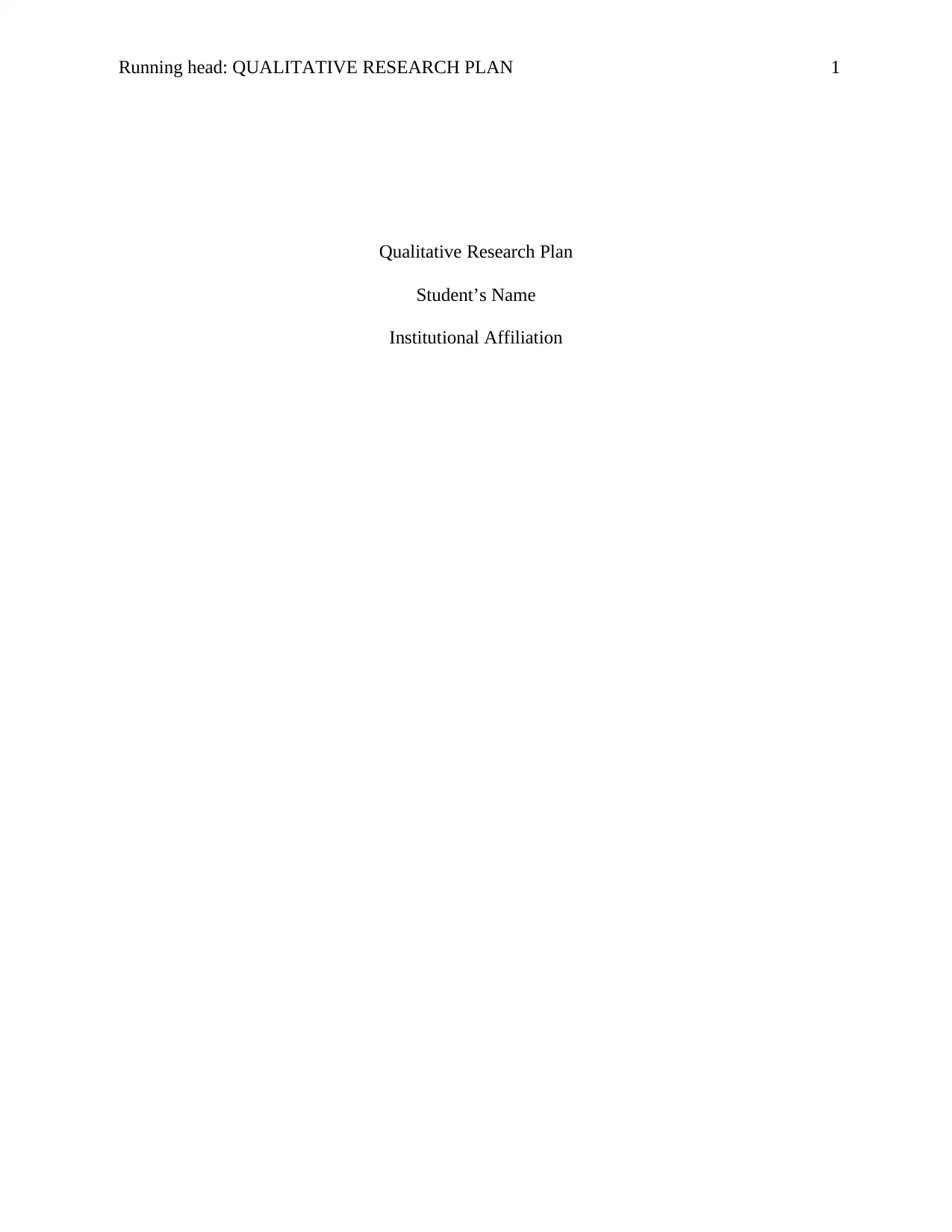
Running head: QUALITATIVE RESEARCH PLAN 1
Qualitative Research Plan
Student’s Name
Institutional Affiliation
Qualitative Research Plan
Student’s Name
Institutional Affiliation
Paraphrase This Document
Need a fresh take? Get an instant paraphrase of this document with our AI Paraphraser
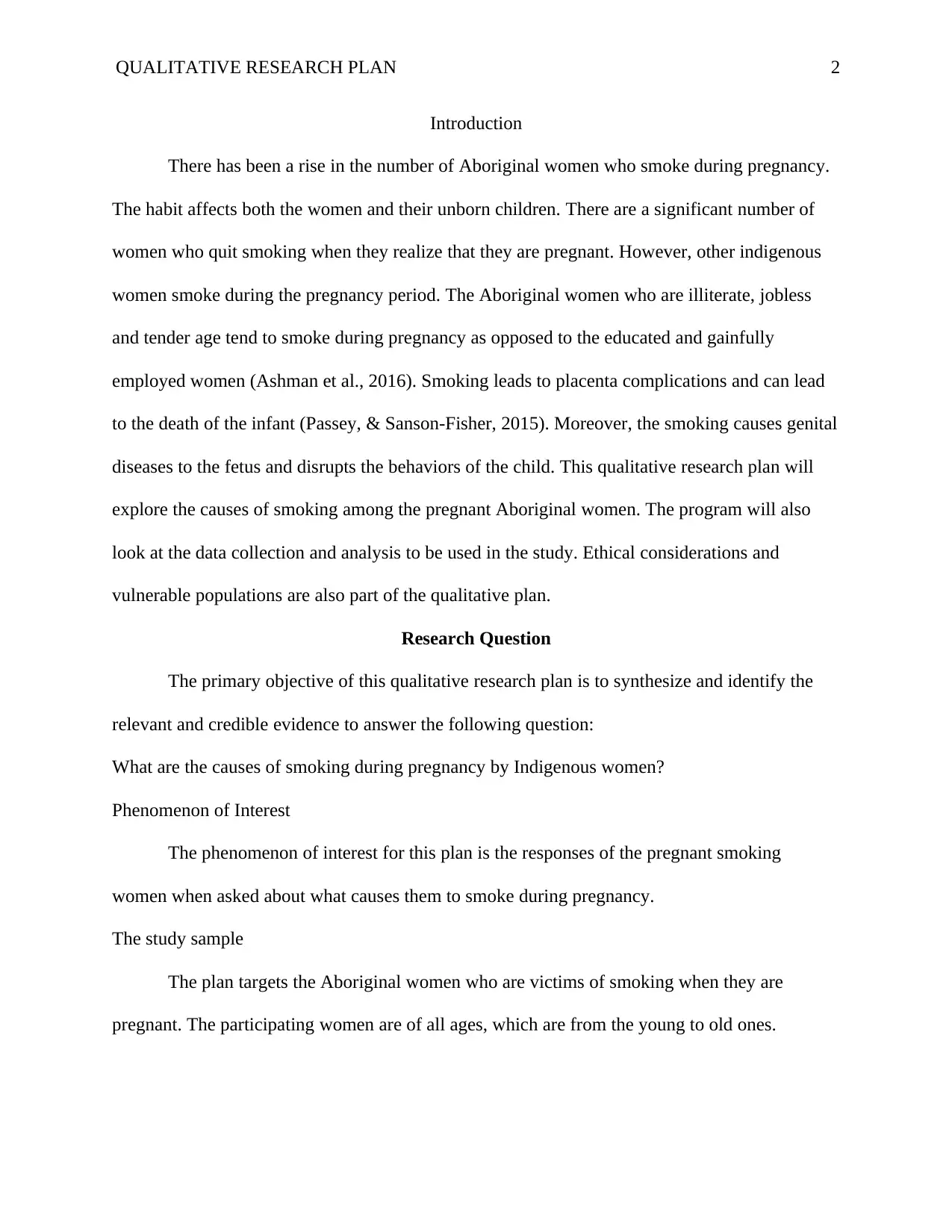
QUALITATIVE RESEARCH PLAN 2
Introduction
There has been a rise in the number of Aboriginal women who smoke during pregnancy.
The habit affects both the women and their unborn children. There are a significant number of
women who quit smoking when they realize that they are pregnant. However, other indigenous
women smoke during the pregnancy period. The Aboriginal women who are illiterate, jobless
and tender age tend to smoke during pregnancy as opposed to the educated and gainfully
employed women (Ashman et al., 2016). Smoking leads to placenta complications and can lead
to the death of the infant (Passey, & Sanson-Fisher, 2015). Moreover, the smoking causes genital
diseases to the fetus and disrupts the behaviors of the child. This qualitative research plan will
explore the causes of smoking among the pregnant Aboriginal women. The program will also
look at the data collection and analysis to be used in the study. Ethical considerations and
vulnerable populations are also part of the qualitative plan.
Research Question
The primary objective of this qualitative research plan is to synthesize and identify the
relevant and credible evidence to answer the following question:
What are the causes of smoking during pregnancy by Indigenous women?
Phenomenon of Interest
The phenomenon of interest for this plan is the responses of the pregnant smoking
women when asked about what causes them to smoke during pregnancy.
The study sample
The plan targets the Aboriginal women who are victims of smoking when they are
pregnant. The participating women are of all ages, which are from the young to old ones.
Introduction
There has been a rise in the number of Aboriginal women who smoke during pregnancy.
The habit affects both the women and their unborn children. There are a significant number of
women who quit smoking when they realize that they are pregnant. However, other indigenous
women smoke during the pregnancy period. The Aboriginal women who are illiterate, jobless
and tender age tend to smoke during pregnancy as opposed to the educated and gainfully
employed women (Ashman et al., 2016). Smoking leads to placenta complications and can lead
to the death of the infant (Passey, & Sanson-Fisher, 2015). Moreover, the smoking causes genital
diseases to the fetus and disrupts the behaviors of the child. This qualitative research plan will
explore the causes of smoking among the pregnant Aboriginal women. The program will also
look at the data collection and analysis to be used in the study. Ethical considerations and
vulnerable populations are also part of the qualitative plan.
Research Question
The primary objective of this qualitative research plan is to synthesize and identify the
relevant and credible evidence to answer the following question:
What are the causes of smoking during pregnancy by Indigenous women?
Phenomenon of Interest
The phenomenon of interest for this plan is the responses of the pregnant smoking
women when asked about what causes them to smoke during pregnancy.
The study sample
The plan targets the Aboriginal women who are victims of smoking when they are
pregnant. The participating women are of all ages, which are from the young to old ones.
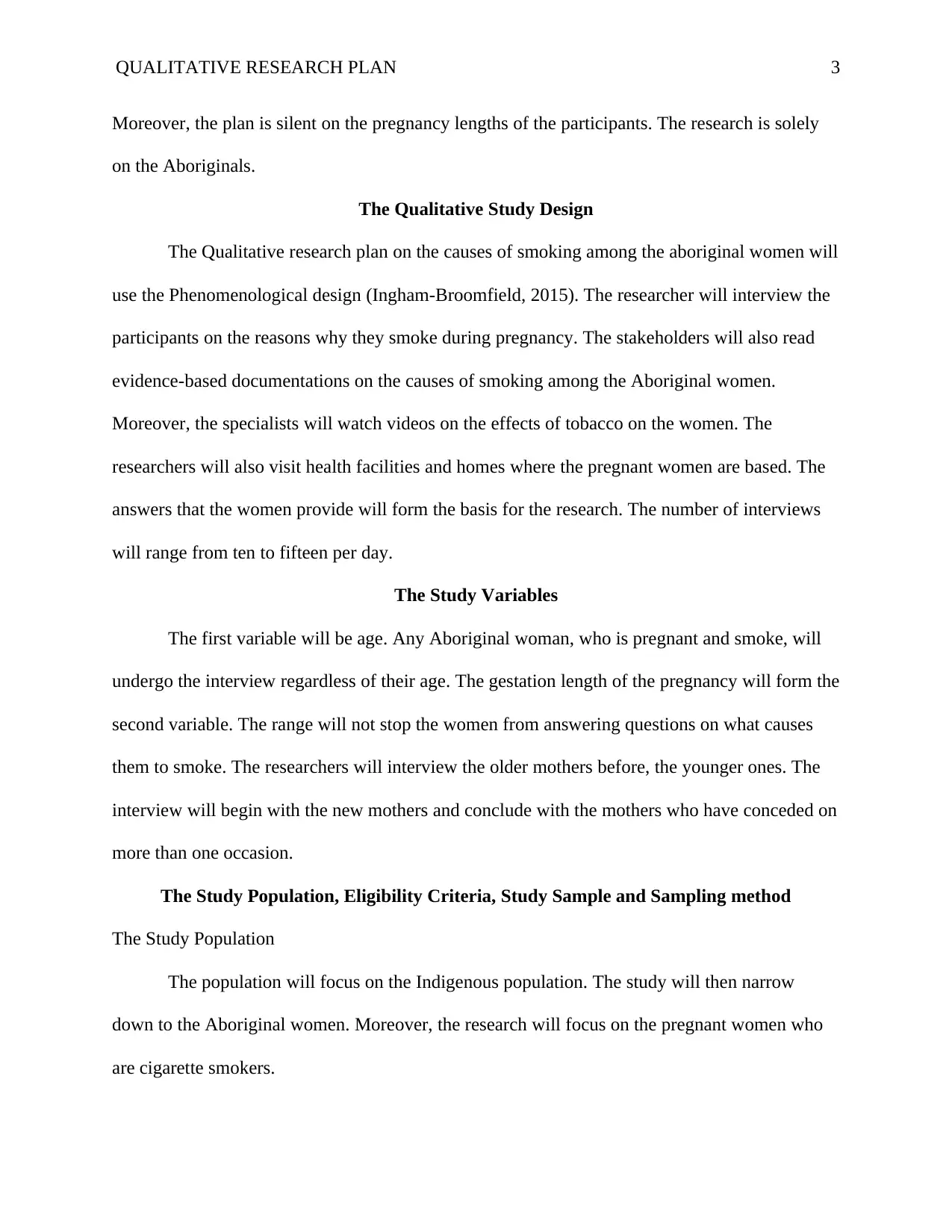
QUALITATIVE RESEARCH PLAN 3
Moreover, the plan is silent on the pregnancy lengths of the participants. The research is solely
on the Aboriginals.
The Qualitative Study Design
The Qualitative research plan on the causes of smoking among the aboriginal women will
use the Phenomenological design (Ingham-Broomfield, 2015). The researcher will interview the
participants on the reasons why they smoke during pregnancy. The stakeholders will also read
evidence-based documentations on the causes of smoking among the Aboriginal women.
Moreover, the specialists will watch videos on the effects of tobacco on the women. The
researchers will also visit health facilities and homes where the pregnant women are based. The
answers that the women provide will form the basis for the research. The number of interviews
will range from ten to fifteen per day.
The Study Variables
The first variable will be age. Any Aboriginal woman, who is pregnant and smoke, will
undergo the interview regardless of their age. The gestation length of the pregnancy will form the
second variable. The range will not stop the women from answering questions on what causes
them to smoke. The researchers will interview the older mothers before, the younger ones. The
interview will begin with the new mothers and conclude with the mothers who have conceded on
more than one occasion.
The Study Population, Eligibility Criteria, Study Sample and Sampling method
The Study Population
The population will focus on the Indigenous population. The study will then narrow
down to the Aboriginal women. Moreover, the research will focus on the pregnant women who
are cigarette smokers.
Moreover, the plan is silent on the pregnancy lengths of the participants. The research is solely
on the Aboriginals.
The Qualitative Study Design
The Qualitative research plan on the causes of smoking among the aboriginal women will
use the Phenomenological design (Ingham-Broomfield, 2015). The researcher will interview the
participants on the reasons why they smoke during pregnancy. The stakeholders will also read
evidence-based documentations on the causes of smoking among the Aboriginal women.
Moreover, the specialists will watch videos on the effects of tobacco on the women. The
researchers will also visit health facilities and homes where the pregnant women are based. The
answers that the women provide will form the basis for the research. The number of interviews
will range from ten to fifteen per day.
The Study Variables
The first variable will be age. Any Aboriginal woman, who is pregnant and smoke, will
undergo the interview regardless of their age. The gestation length of the pregnancy will form the
second variable. The range will not stop the women from answering questions on what causes
them to smoke. The researchers will interview the older mothers before, the younger ones. The
interview will begin with the new mothers and conclude with the mothers who have conceded on
more than one occasion.
The Study Population, Eligibility Criteria, Study Sample and Sampling method
The Study Population
The population will focus on the Indigenous population. The study will then narrow
down to the Aboriginal women. Moreover, the research will focus on the pregnant women who
are cigarette smokers.
⊘ This is a preview!⊘
Do you want full access?
Subscribe today to unlock all pages.

Trusted by 1+ million students worldwide
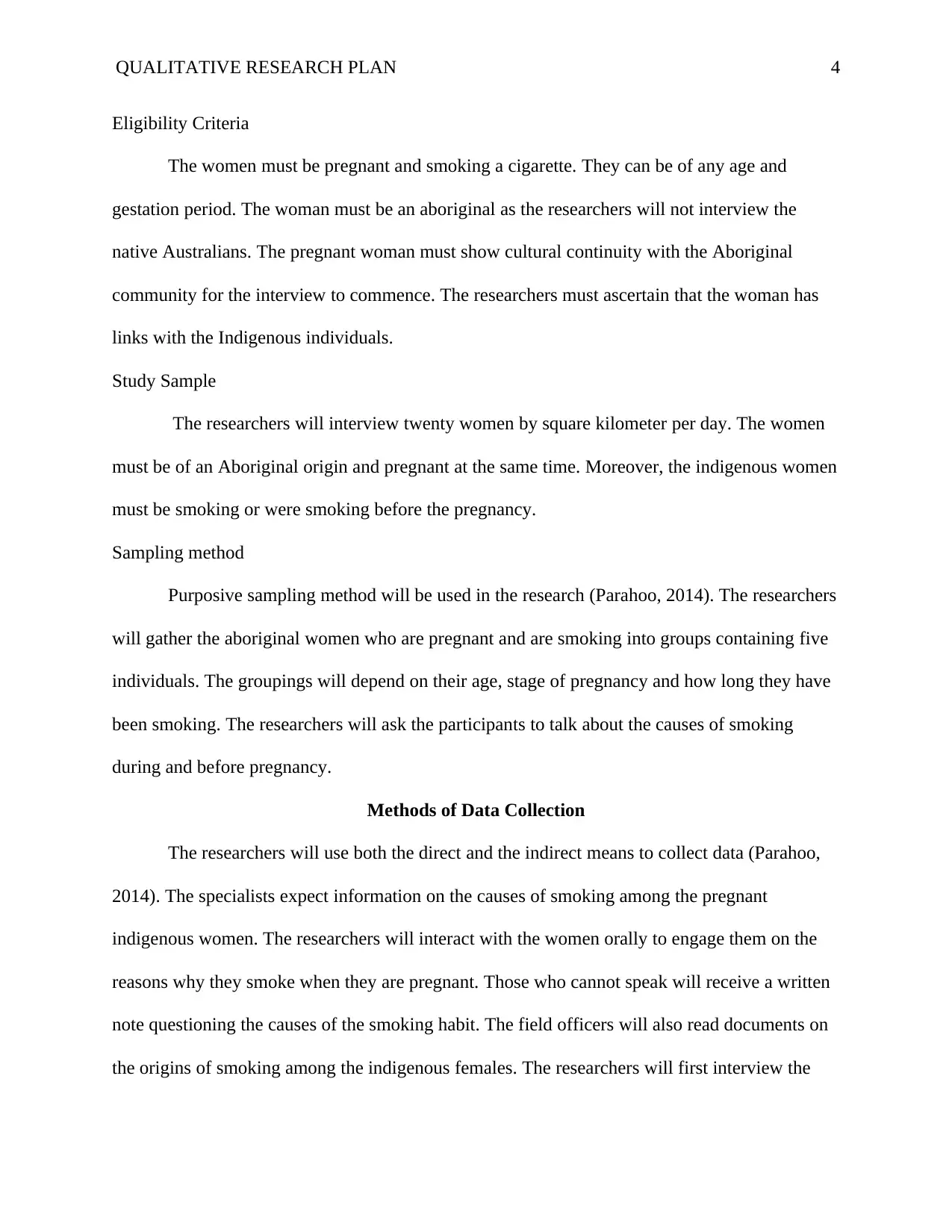
QUALITATIVE RESEARCH PLAN 4
Eligibility Criteria
The women must be pregnant and smoking a cigarette. They can be of any age and
gestation period. The woman must be an aboriginal as the researchers will not interview the
native Australians. The pregnant woman must show cultural continuity with the Aboriginal
community for the interview to commence. The researchers must ascertain that the woman has
links with the Indigenous individuals.
Study Sample
The researchers will interview twenty women by square kilometer per day. The women
must be of an Aboriginal origin and pregnant at the same time. Moreover, the indigenous women
must be smoking or were smoking before the pregnancy.
Sampling method
Purposive sampling method will be used in the research (Parahoo, 2014). The researchers
will gather the aboriginal women who are pregnant and are smoking into groups containing five
individuals. The groupings will depend on their age, stage of pregnancy and how long they have
been smoking. The researchers will ask the participants to talk about the causes of smoking
during and before pregnancy.
Methods of Data Collection
The researchers will use both the direct and the indirect means to collect data (Parahoo,
2014). The specialists expect information on the causes of smoking among the pregnant
indigenous women. The researchers will interact with the women orally to engage them on the
reasons why they smoke when they are pregnant. Those who cannot speak will receive a written
note questioning the causes of the smoking habit. The field officers will also read documents on
the origins of smoking among the indigenous females. The researchers will first interview the
Eligibility Criteria
The women must be pregnant and smoking a cigarette. They can be of any age and
gestation period. The woman must be an aboriginal as the researchers will not interview the
native Australians. The pregnant woman must show cultural continuity with the Aboriginal
community for the interview to commence. The researchers must ascertain that the woman has
links with the Indigenous individuals.
Study Sample
The researchers will interview twenty women by square kilometer per day. The women
must be of an Aboriginal origin and pregnant at the same time. Moreover, the indigenous women
must be smoking or were smoking before the pregnancy.
Sampling method
Purposive sampling method will be used in the research (Parahoo, 2014). The researchers
will gather the aboriginal women who are pregnant and are smoking into groups containing five
individuals. The groupings will depend on their age, stage of pregnancy and how long they have
been smoking. The researchers will ask the participants to talk about the causes of smoking
during and before pregnancy.
Methods of Data Collection
The researchers will use both the direct and the indirect means to collect data (Parahoo,
2014). The specialists expect information on the causes of smoking among the pregnant
indigenous women. The researchers will interact with the women orally to engage them on the
reasons why they smoke when they are pregnant. Those who cannot speak will receive a written
note questioning the causes of the smoking habit. The field officers will also read documents on
the origins of smoking among the indigenous females. The researchers will first interview the
Paraphrase This Document
Need a fresh take? Get an instant paraphrase of this document with our AI Paraphraser
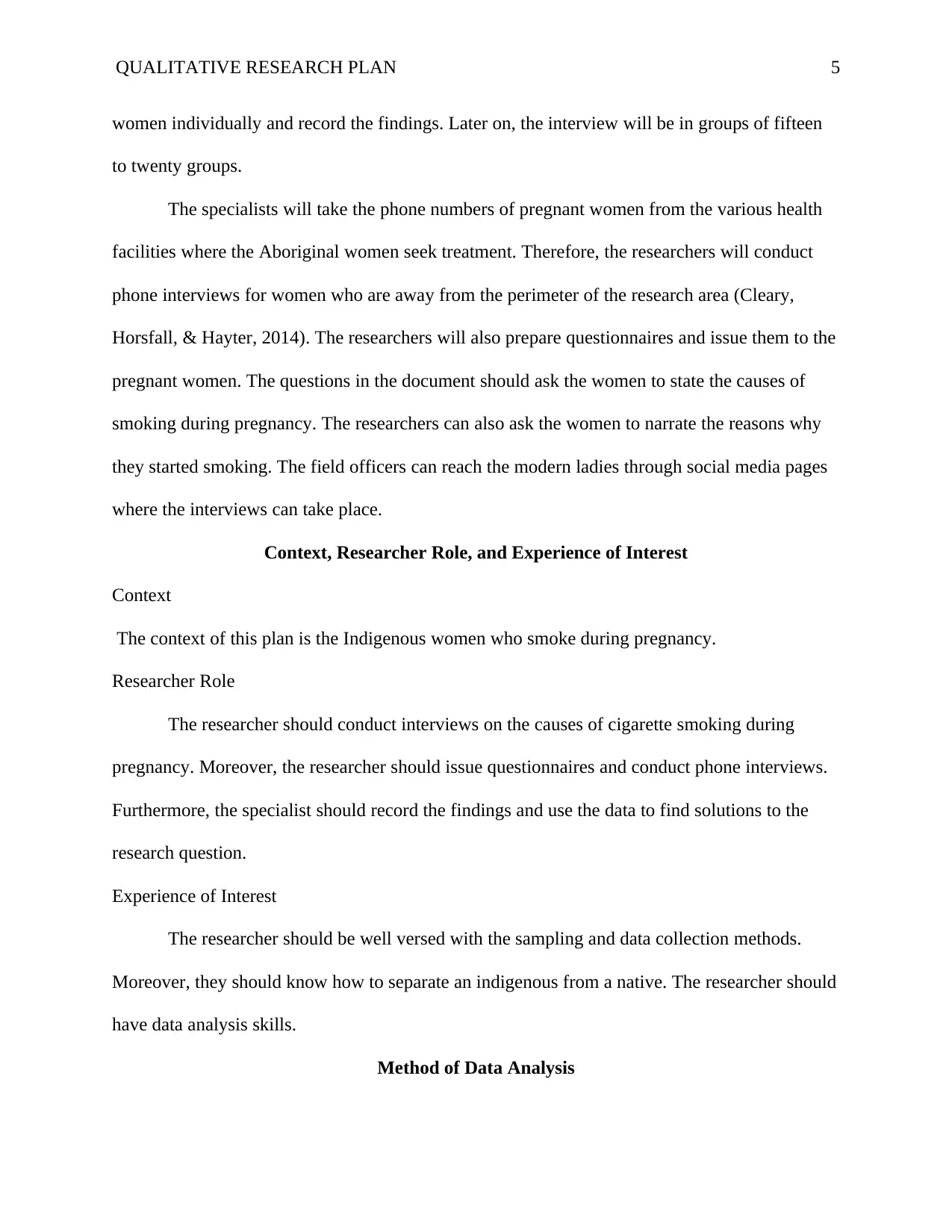
QUALITATIVE RESEARCH PLAN 5
women individually and record the findings. Later on, the interview will be in groups of fifteen
to twenty groups.
The specialists will take the phone numbers of pregnant women from the various health
facilities where the Aboriginal women seek treatment. Therefore, the researchers will conduct
phone interviews for women who are away from the perimeter of the research area (Cleary,
Horsfall, & Hayter, 2014). The researchers will also prepare questionnaires and issue them to the
pregnant women. The questions in the document should ask the women to state the causes of
smoking during pregnancy. The researchers can also ask the women to narrate the reasons why
they started smoking. The field officers can reach the modern ladies through social media pages
where the interviews can take place.
Context, Researcher Role, and Experience of Interest
Context
The context of this plan is the Indigenous women who smoke during pregnancy.
Researcher Role
The researcher should conduct interviews on the causes of cigarette smoking during
pregnancy. Moreover, the researcher should issue questionnaires and conduct phone interviews.
Furthermore, the specialist should record the findings and use the data to find solutions to the
research question.
Experience of Interest
The researcher should be well versed with the sampling and data collection methods.
Moreover, they should know how to separate an indigenous from a native. The researcher should
have data analysis skills.
Method of Data Analysis
women individually and record the findings. Later on, the interview will be in groups of fifteen
to twenty groups.
The specialists will take the phone numbers of pregnant women from the various health
facilities where the Aboriginal women seek treatment. Therefore, the researchers will conduct
phone interviews for women who are away from the perimeter of the research area (Cleary,
Horsfall, & Hayter, 2014). The researchers will also prepare questionnaires and issue them to the
pregnant women. The questions in the document should ask the women to state the causes of
smoking during pregnancy. The researchers can also ask the women to narrate the reasons why
they started smoking. The field officers can reach the modern ladies through social media pages
where the interviews can take place.
Context, Researcher Role, and Experience of Interest
Context
The context of this plan is the Indigenous women who smoke during pregnancy.
Researcher Role
The researcher should conduct interviews on the causes of cigarette smoking during
pregnancy. Moreover, the researcher should issue questionnaires and conduct phone interviews.
Furthermore, the specialist should record the findings and use the data to find solutions to the
research question.
Experience of Interest
The researcher should be well versed with the sampling and data collection methods.
Moreover, they should know how to separate an indigenous from a native. The researcher should
have data analysis skills.
Method of Data Analysis
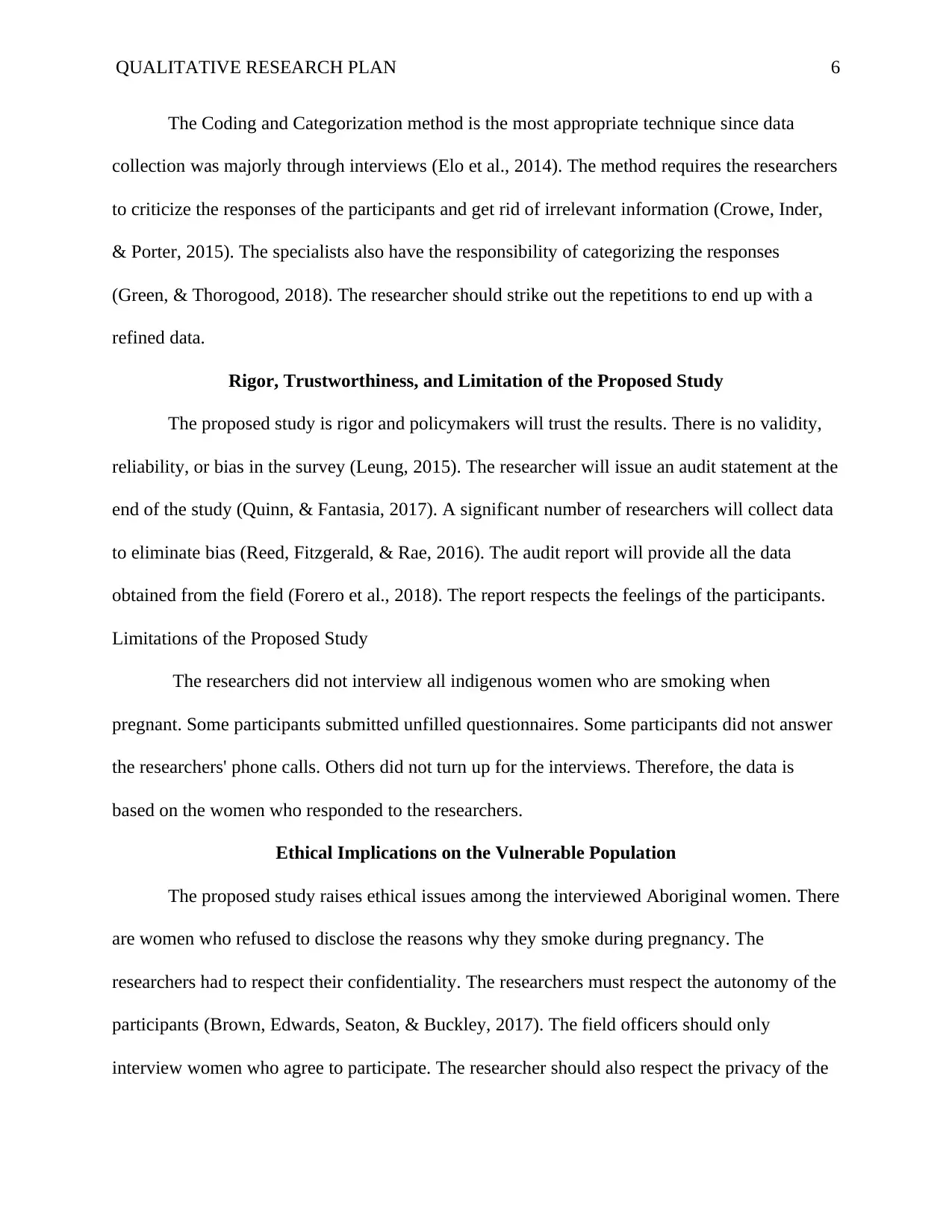
QUALITATIVE RESEARCH PLAN 6
The Coding and Categorization method is the most appropriate technique since data
collection was majorly through interviews (Elo et al., 2014). The method requires the researchers
to criticize the responses of the participants and get rid of irrelevant information (Crowe, Inder,
& Porter, 2015). The specialists also have the responsibility of categorizing the responses
(Green, & Thorogood, 2018). The researcher should strike out the repetitions to end up with a
refined data.
Rigor, Trustworthiness, and Limitation of the Proposed Study
The proposed study is rigor and policymakers will trust the results. There is no validity,
reliability, or bias in the survey (Leung, 2015). The researcher will issue an audit statement at the
end of the study (Quinn, & Fantasia, 2017). A significant number of researchers will collect data
to eliminate bias (Reed, Fitzgerald, & Rae, 2016). The audit report will provide all the data
obtained from the field (Forero et al., 2018). The report respects the feelings of the participants.
Limitations of the Proposed Study
The researchers did not interview all indigenous women who are smoking when
pregnant. Some participants submitted unfilled questionnaires. Some participants did not answer
the researchers' phone calls. Others did not turn up for the interviews. Therefore, the data is
based on the women who responded to the researchers.
Ethical Implications on the Vulnerable Population
The proposed study raises ethical issues among the interviewed Aboriginal women. There
are women who refused to disclose the reasons why they smoke during pregnancy. The
researchers had to respect their confidentiality. The researchers must respect the autonomy of the
participants (Brown, Edwards, Seaton, & Buckley, 2017). The field officers should only
interview women who agree to participate. The researcher should also respect the privacy of the
The Coding and Categorization method is the most appropriate technique since data
collection was majorly through interviews (Elo et al., 2014). The method requires the researchers
to criticize the responses of the participants and get rid of irrelevant information (Crowe, Inder,
& Porter, 2015). The specialists also have the responsibility of categorizing the responses
(Green, & Thorogood, 2018). The researcher should strike out the repetitions to end up with a
refined data.
Rigor, Trustworthiness, and Limitation of the Proposed Study
The proposed study is rigor and policymakers will trust the results. There is no validity,
reliability, or bias in the survey (Leung, 2015). The researcher will issue an audit statement at the
end of the study (Quinn, & Fantasia, 2017). A significant number of researchers will collect data
to eliminate bias (Reed, Fitzgerald, & Rae, 2016). The audit report will provide all the data
obtained from the field (Forero et al., 2018). The report respects the feelings of the participants.
Limitations of the Proposed Study
The researchers did not interview all indigenous women who are smoking when
pregnant. Some participants submitted unfilled questionnaires. Some participants did not answer
the researchers' phone calls. Others did not turn up for the interviews. Therefore, the data is
based on the women who responded to the researchers.
Ethical Implications on the Vulnerable Population
The proposed study raises ethical issues among the interviewed Aboriginal women. There
are women who refused to disclose the reasons why they smoke during pregnancy. The
researchers had to respect their confidentiality. The researchers must respect the autonomy of the
participants (Brown, Edwards, Seaton, & Buckley, 2017). The field officers should only
interview women who agree to participate. The researcher should also respect the privacy of the
⊘ This is a preview!⊘
Do you want full access?
Subscribe today to unlock all pages.

Trusted by 1+ million students worldwide
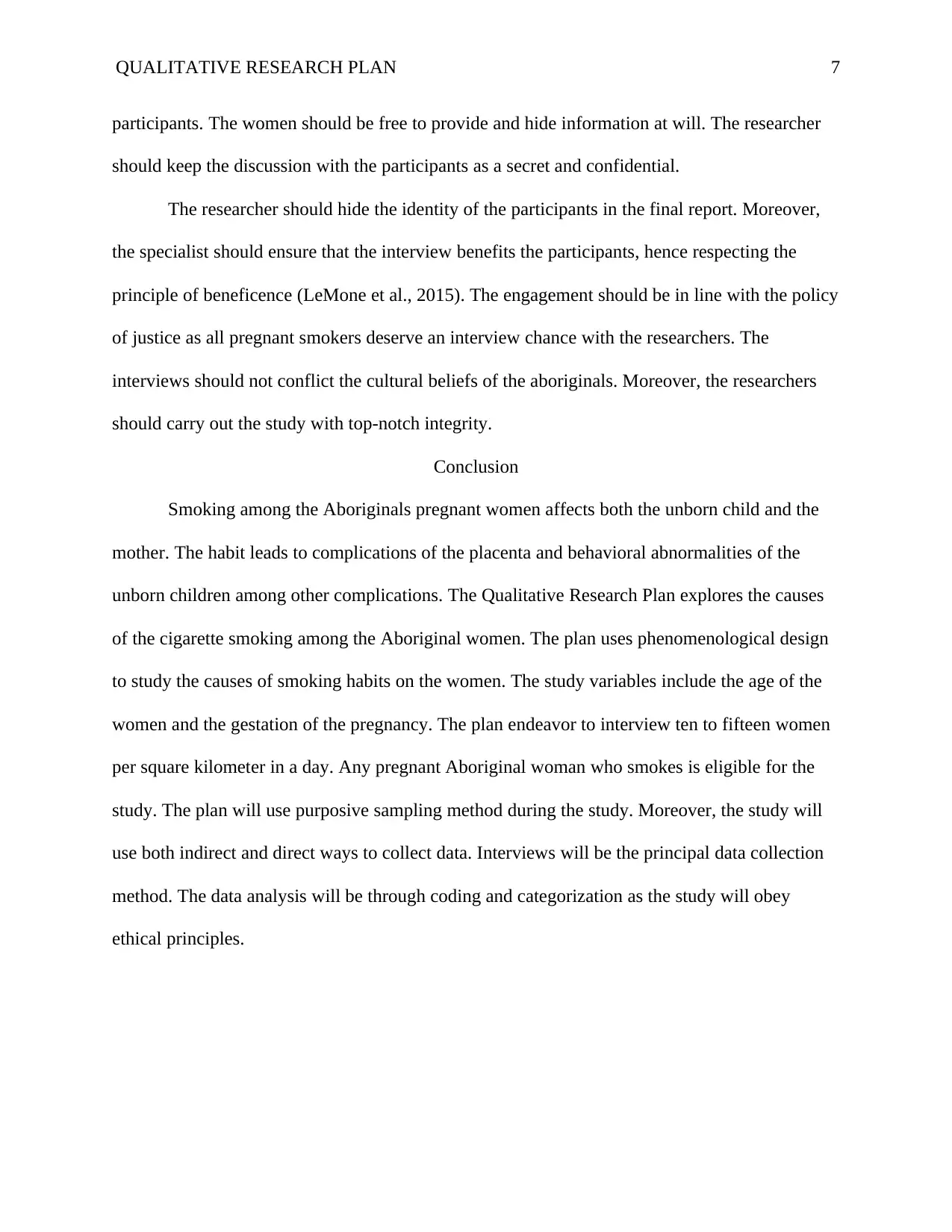
QUALITATIVE RESEARCH PLAN 7
participants. The women should be free to provide and hide information at will. The researcher
should keep the discussion with the participants as a secret and confidential.
The researcher should hide the identity of the participants in the final report. Moreover,
the specialist should ensure that the interview benefits the participants, hence respecting the
principle of beneficence (LeMone et al., 2015). The engagement should be in line with the policy
of justice as all pregnant smokers deserve an interview chance with the researchers. The
interviews should not conflict the cultural beliefs of the aboriginals. Moreover, the researchers
should carry out the study with top-notch integrity.
Conclusion
Smoking among the Aboriginals pregnant women affects both the unborn child and the
mother. The habit leads to complications of the placenta and behavioral abnormalities of the
unborn children among other complications. The Qualitative Research Plan explores the causes
of the cigarette smoking among the Aboriginal women. The plan uses phenomenological design
to study the causes of smoking habits on the women. The study variables include the age of the
women and the gestation of the pregnancy. The plan endeavor to interview ten to fifteen women
per square kilometer in a day. Any pregnant Aboriginal woman who smokes is eligible for the
study. The plan will use purposive sampling method during the study. Moreover, the study will
use both indirect and direct ways to collect data. Interviews will be the principal data collection
method. The data analysis will be through coding and categorization as the study will obey
ethical principles.
participants. The women should be free to provide and hide information at will. The researcher
should keep the discussion with the participants as a secret and confidential.
The researcher should hide the identity of the participants in the final report. Moreover,
the specialist should ensure that the interview benefits the participants, hence respecting the
principle of beneficence (LeMone et al., 2015). The engagement should be in line with the policy
of justice as all pregnant smokers deserve an interview chance with the researchers. The
interviews should not conflict the cultural beliefs of the aboriginals. Moreover, the researchers
should carry out the study with top-notch integrity.
Conclusion
Smoking among the Aboriginals pregnant women affects both the unborn child and the
mother. The habit leads to complications of the placenta and behavioral abnormalities of the
unborn children among other complications. The Qualitative Research Plan explores the causes
of the cigarette smoking among the Aboriginal women. The plan uses phenomenological design
to study the causes of smoking habits on the women. The study variables include the age of the
women and the gestation of the pregnancy. The plan endeavor to interview ten to fifteen women
per square kilometer in a day. Any pregnant Aboriginal woman who smokes is eligible for the
study. The plan will use purposive sampling method during the study. Moreover, the study will
use both indirect and direct ways to collect data. Interviews will be the principal data collection
method. The data analysis will be through coding and categorization as the study will obey
ethical principles.
Paraphrase This Document
Need a fresh take? Get an instant paraphrase of this document with our AI Paraphraser
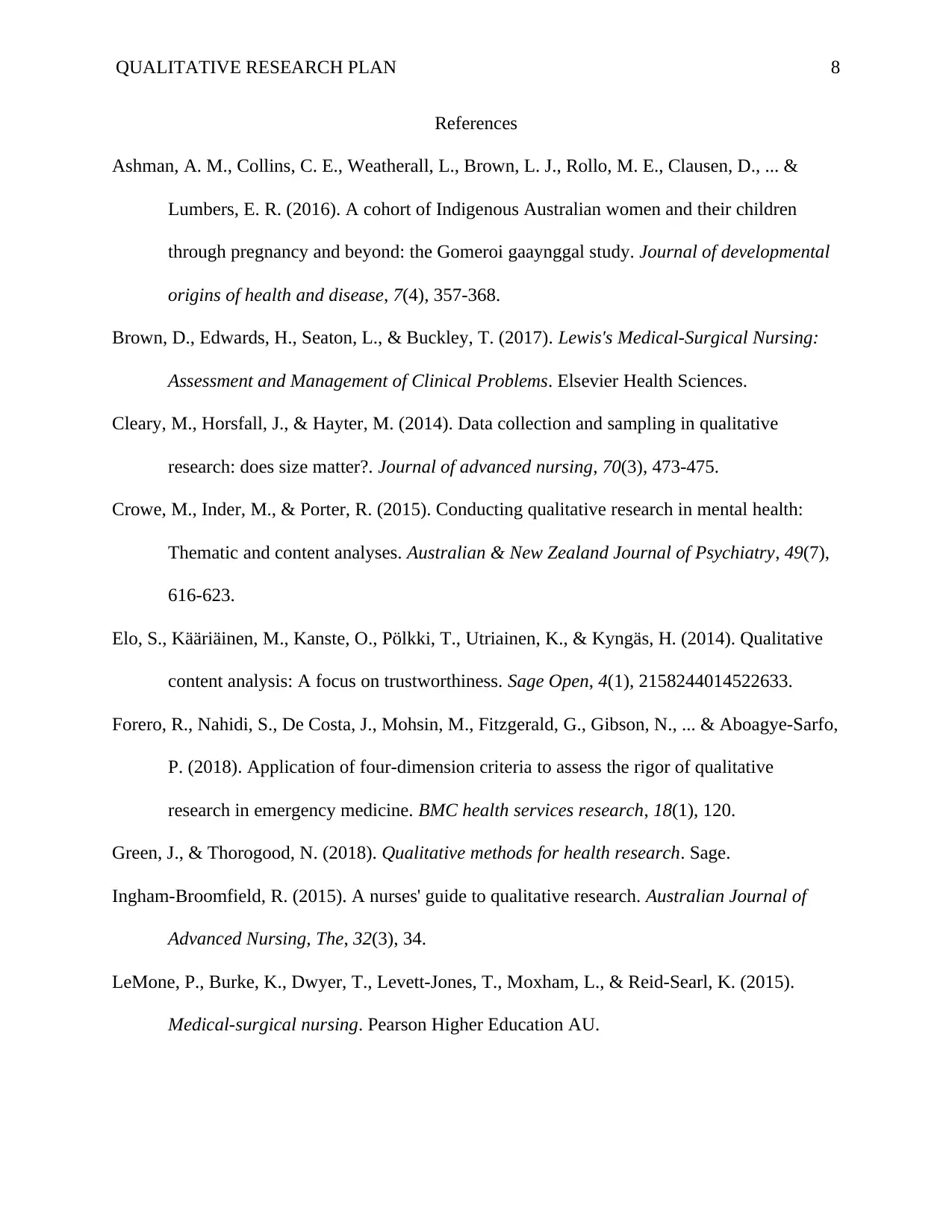
QUALITATIVE RESEARCH PLAN 8
References
Ashman, A. M., Collins, C. E., Weatherall, L., Brown, L. J., Rollo, M. E., Clausen, D., ... &
Lumbers, E. R. (2016). A cohort of Indigenous Australian women and their children
through pregnancy and beyond: the Gomeroi gaaynggal study. Journal of developmental
origins of health and disease, 7(4), 357-368.
Brown, D., Edwards, H., Seaton, L., & Buckley, T. (2017). Lewis's Medical-Surgical Nursing:
Assessment and Management of Clinical Problems. Elsevier Health Sciences.
Cleary, M., Horsfall, J., & Hayter, M. (2014). Data collection and sampling in qualitative
research: does size matter?. Journal of advanced nursing, 70(3), 473-475.
Crowe, M., Inder, M., & Porter, R. (2015). Conducting qualitative research in mental health:
Thematic and content analyses. Australian & New Zealand Journal of Psychiatry, 49(7),
616-623.
Elo, S., Kääriäinen, M., Kanste, O., Pölkki, T., Utriainen, K., & Kyngäs, H. (2014). Qualitative
content analysis: A focus on trustworthiness. Sage Open, 4(1), 2158244014522633.
Forero, R., Nahidi, S., De Costa, J., Mohsin, M., Fitzgerald, G., Gibson, N., ... & Aboagye-Sarfo,
P. (2018). Application of four-dimension criteria to assess the rigor of qualitative
research in emergency medicine. BMC health services research, 18(1), 120.
Green, J., & Thorogood, N. (2018). Qualitative methods for health research. Sage.
Ingham-Broomfield, R. (2015). A nurses' guide to qualitative research. Australian Journal of
Advanced Nursing, The, 32(3), 34.
LeMone, P., Burke, K., Dwyer, T., Levett-Jones, T., Moxham, L., & Reid-Searl, K. (2015).
Medical-surgical nursing. Pearson Higher Education AU.
References
Ashman, A. M., Collins, C. E., Weatherall, L., Brown, L. J., Rollo, M. E., Clausen, D., ... &
Lumbers, E. R. (2016). A cohort of Indigenous Australian women and their children
through pregnancy and beyond: the Gomeroi gaaynggal study. Journal of developmental
origins of health and disease, 7(4), 357-368.
Brown, D., Edwards, H., Seaton, L., & Buckley, T. (2017). Lewis's Medical-Surgical Nursing:
Assessment and Management of Clinical Problems. Elsevier Health Sciences.
Cleary, M., Horsfall, J., & Hayter, M. (2014). Data collection and sampling in qualitative
research: does size matter?. Journal of advanced nursing, 70(3), 473-475.
Crowe, M., Inder, M., & Porter, R. (2015). Conducting qualitative research in mental health:
Thematic and content analyses. Australian & New Zealand Journal of Psychiatry, 49(7),
616-623.
Elo, S., Kääriäinen, M., Kanste, O., Pölkki, T., Utriainen, K., & Kyngäs, H. (2014). Qualitative
content analysis: A focus on trustworthiness. Sage Open, 4(1), 2158244014522633.
Forero, R., Nahidi, S., De Costa, J., Mohsin, M., Fitzgerald, G., Gibson, N., ... & Aboagye-Sarfo,
P. (2018). Application of four-dimension criteria to assess the rigor of qualitative
research in emergency medicine. BMC health services research, 18(1), 120.
Green, J., & Thorogood, N. (2018). Qualitative methods for health research. Sage.
Ingham-Broomfield, R. (2015). A nurses' guide to qualitative research. Australian Journal of
Advanced Nursing, The, 32(3), 34.
LeMone, P., Burke, K., Dwyer, T., Levett-Jones, T., Moxham, L., & Reid-Searl, K. (2015).
Medical-surgical nursing. Pearson Higher Education AU.
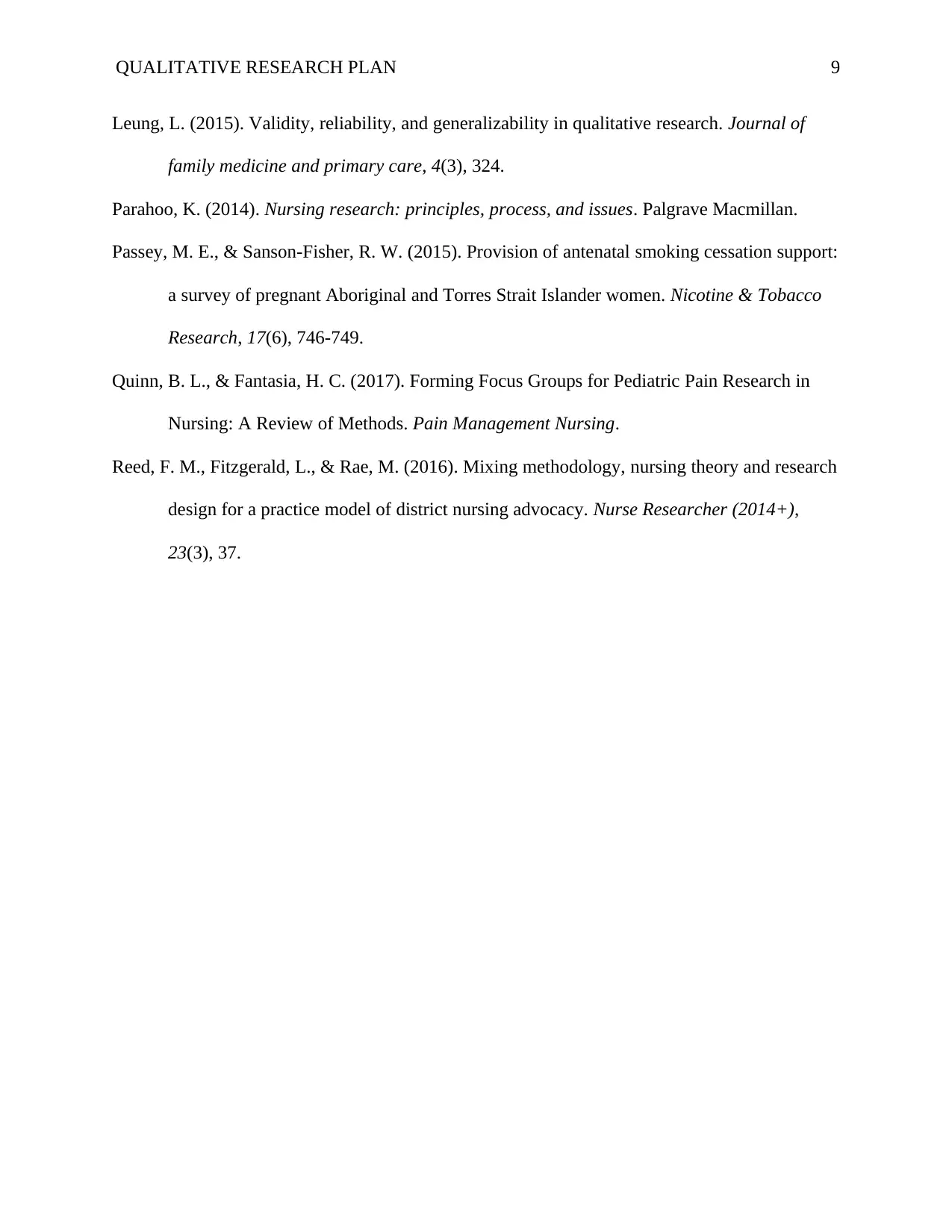
QUALITATIVE RESEARCH PLAN 9
Leung, L. (2015). Validity, reliability, and generalizability in qualitative research. Journal of
family medicine and primary care, 4(3), 324.
Parahoo, K. (2014). Nursing research: principles, process, and issues. Palgrave Macmillan.
Passey, M. E., & Sanson-Fisher, R. W. (2015). Provision of antenatal smoking cessation support:
a survey of pregnant Aboriginal and Torres Strait Islander women. Nicotine & Tobacco
Research, 17(6), 746-749.
Quinn, B. L., & Fantasia, H. C. (2017). Forming Focus Groups for Pediatric Pain Research in
Nursing: A Review of Methods. Pain Management Nursing.
Reed, F. M., Fitzgerald, L., & Rae, M. (2016). Mixing methodology, nursing theory and research
design for a practice model of district nursing advocacy. Nurse Researcher (2014+),
23(3), 37.
Leung, L. (2015). Validity, reliability, and generalizability in qualitative research. Journal of
family medicine and primary care, 4(3), 324.
Parahoo, K. (2014). Nursing research: principles, process, and issues. Palgrave Macmillan.
Passey, M. E., & Sanson-Fisher, R. W. (2015). Provision of antenatal smoking cessation support:
a survey of pregnant Aboriginal and Torres Strait Islander women. Nicotine & Tobacco
Research, 17(6), 746-749.
Quinn, B. L., & Fantasia, H. C. (2017). Forming Focus Groups for Pediatric Pain Research in
Nursing: A Review of Methods. Pain Management Nursing.
Reed, F. M., Fitzgerald, L., & Rae, M. (2016). Mixing methodology, nursing theory and research
design for a practice model of district nursing advocacy. Nurse Researcher (2014+),
23(3), 37.
⊘ This is a preview!⊘
Do you want full access?
Subscribe today to unlock all pages.

Trusted by 1+ million students worldwide
1 out of 9
Related Documents
Your All-in-One AI-Powered Toolkit for Academic Success.
+13062052269
info@desklib.com
Available 24*7 on WhatsApp / Email
![[object Object]](/_next/static/media/star-bottom.7253800d.svg)
Unlock your academic potential
Copyright © 2020–2025 A2Z Services. All Rights Reserved. Developed and managed by ZUCOL.





